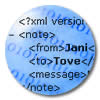XML Primer


 |
XML was designed to describe data and to focus on what data is.
HTML was designed to display data and to focus on how data looks.
|
What is XML?
- XML stands for EXtensible Markup Language
- XML is a markup language much like HTML
- XML was designed to describe data
- XML tags are not predefined. You must define your own tags
- XML uses a Document Type Definition (DTD) or an XML Schema
to describe the data
- XML with a DTD or XML Schema is designed to be self-descriptive
- XML is a W3C Recommendation
The Main Difference between XML and HTML
XML was designed to carry data.
XML is not a replacement for HTML.
XML and HTML were designed with different goals:
XML was designed to describe
data and to focus on what data is.
HTML was
designed to display data and to focus on how data looks.
HTML is about displaying information, while XML is about describing
information.
XML Does not DO Anything
XML was not designed to DO anything.
Maybe it is a little hard to understand, but XML does not DO anything.
XML was created to structure, store and to send
information.
The following example is a note to Tove from Jani, stored as XML:
<note>
<to>Tove</to>
<from>Jani</from>
<heading>Reminder</heading>
<body>Don't forget me this weekend!</body>
</note>
|
The note has a header and a message body. It also has sender and receiver
information. But still, this XML document does not DO anything. It is just pure
information wrapped in XML tags. Someone must write a piece of software to send, receive or display it.
XML is Free and Extensible
XML tags are not predefined. You must "invent" your own tags.
The tags used to mark up HTML documents and the structure of HTML documents
are predefined. The author of HTML documents can only use tags that are
defined in the HTML standard (like <p>, <h1>, etc.).
XML allows the author to define his own tags and his own document
structure.
The tags in the example above (like <to> and <from>) are not
defined in any XML standard. These tags are "invented" by the author
of the XML document.
XML is a Complement to HTML
XML is not a replacement for HTML.
It is important to understand that XML is not a replacement for HTML. In
future Web development it is most likely that XML will be used to describe the data, while HTML will be used to format and
display the same data.
My best description of XML is this: XML is a cross-platform, software and hardware
independent tool for transmitting information.
XML in Future Web Development
XML is going to be everywhere.
We have been participating in XML development since its creation. It
has been amazing to see how quickly the XML standard has been developed and how
quickly a large number of software vendors have adopted the standard.
We strongly believe that XML will be as important to the future of the Web as
HTML has been to the foundation of the Web and that XML will be the most common
tool for all data manipulation and data transmission.
XML Tutorial
Study our Complete XML Tutorial


Reliable, affordable, feature-rich web hosting!

Take the uncertainty out of Web hosting and let
GoDaddy.com
put service, performance and value back in. No matter which
hosting type or plan you choose, your site receives 24/7
maintenance and protection in our world-class data center. Plus,
you get the expert, friendly service you deserve, from the
world's largest hostname provider.
With three plans to choose from and
prices starting at just $4.99 per month, GoDaddy.com is sure to have a plan that's
right-sized and right-priced just for you!
All plans feature FREE 24x7 setup, FREE 24x7 monitoring, best-
of-breed routers, firewalls and servers, 24x7 onsite physical security
and access to our exclusive Go Daddy Hosting Connection, THE place
to install over 30 FREE applications. Virtual Dedicated and Dedicated
Server plans also available.
Visit GoDaddy.com today.
Virtual Dedicated, Dedicated Server and unlimited plans also available.
Save 10% on web hosting - Enter code w3tenoff at checkout
 |
|
Get Your Diploma!
W3Schools' Online Certification Program is the perfect solution for busy
professionals who need to balance work, family, and career building.
The HTML Certificate is for developers who want to document their knowledge of HTML, XHTML, and CSS.
The JavaScript Certificate is for developers who want to document their knowledge of JavaScript and the HTML DOM.
The XML Certificate is for developers who want to document their knowledge of XML, XML DOM and XSLT.
The ASP Certificate is for developers who want to document their knowledge of ASP, SQL, and ADO.
The PHP Certificate is for developers who want to document their knowledge of PHP and SQL (MySQL).
|
|